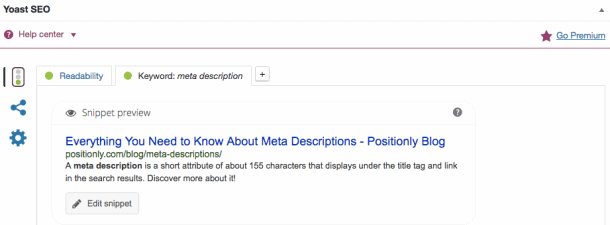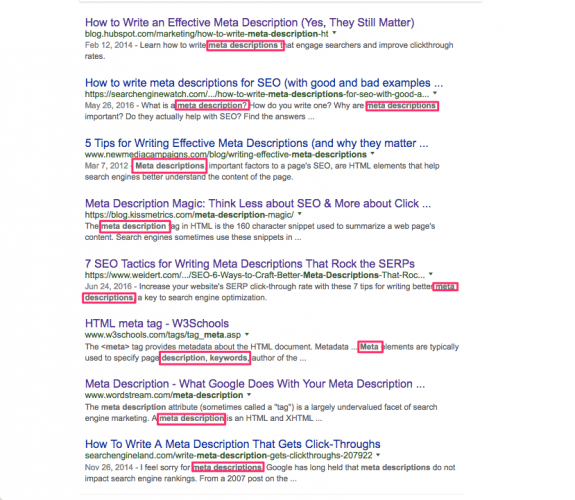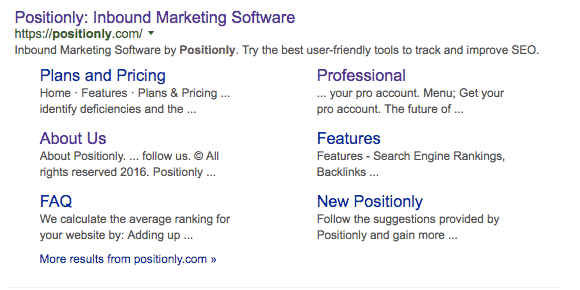The meta description is about a 160 character snippet, a tag in HTML, that summarizes page content. Search engines show the meta description in search results mostly when the searched for phrase is contained in the description. Optimizing the meta description is a very important aspect of on-page SEO.
The function of a meta description for your page is simple: its main purpose is to get the visitor from Google to click your link. In other words, meta descriptions are there to generate clickthroughs from search engines.
What is Metadata in HTML
Metadata is information about your HTML document that isn’t visible on a page, but is in the search results. Metadata usually specifies the page description; author of the asset; the date of publication or the date of the last update; keywords, etc. Metadata is supported by all the major browsers such as Google Chrome, Internet Explorer, Mozilla, Opera, and Safari.
Search engines don’t use metadata as a ranking factor in their algorithms and SEO experts discourage website owners from adding meta keywords to the HTML of a page. Why? Mainly because these meta keywords don’t help anyone with anything apart from showing your competitors what keywords you are trying to optimize your pages for. So better skip on meta keywords.
On the other hand, there are meta titles and meta descriptions which are still super important for any HTML document. In this piece of writing, we are going to explain how to write a meta description and what the benefits behind it are.
What is a Meta Description?
Meta descriptions display preview snippets for a specific page, giving a clear idea of your site’s content straight from the search results and encouraging users to click-through to your site. This makes it a paramount part of search marketing. A meta description is a short HTML attribute of about 155 characters – including spaces – and displays under the title tag and link in the search results.
Description in META tag
“The description tag is one of the most important elements shown to the users for the typed query. The meta description is presented as a snippet of your content. It tells your potential visitors what kind of information they can find on your web page.”
Optimal Meta Description Length
“The meta description is used by Google to present your website’s content on a search engine results page. The amount of characters that could be displayed is limited, though. Shorten the description of your site and try not to exceed 160 bytes.”
Meta Description Code Example:
<head>
<meta name=”description” content= “When migrating your website, there is always a risk to lose your keyword rankings. Discover everything you need to do to avoid SEO migration disaster.”/>
</head>
Meta Description in Search Results:

WordPress Meta Description: (by Yoast SEO)

Its function is to summarize the content of a particular page. The better written your meta description is, the more click-throughs it drives. Meta description optimization is a necessary part of on-page SEO.
The best examples of meta descriptions come from search engines themselves. Anytime you want to check how to create yours, look at Google, Bing or Yahoo.
Is a Meta Description a Ranking Factor?
A meta description tag isn’t a direct ranking factor; however, there is a strong correlation between higher rankings and a well-crafted meta description. That’s because this short paragraph provides a unique chance to advertise your content to the searchers and convince them to read further.
A compelling meta description makes people click-through from SERPs, positively impacting your click-through rate. CTR already belongs to the list of behavioral factors that have a strong influence on search rankings.
Meta Description Length
Your meta descriptions should accurately convey and wrap up what your page is about within one or two sentences.
Search engines have limited space and aren’t capable of displaying long meta descriptions on SERPs. So the character limit of a meta description is 155 characters. – This is what can be fully displayed without any cut offs. Longer descriptions will end up being cut in the middle of what you wanted to say. So make them engaging but concise.
Search engines can also add some extra snippets to your results, making your meta description even shorter. So don’t go for the maximum meta description length, find your optimum instead. For instance, we usually stick to 150 characters.
Incorporate CTA
Your meta description should work for you. As the name itself suggests, it should be descriptive and written in a way that encourages clicks. The second part of your meta description should promise to benefit readers in some way and make them click in order to find out more. At the end of your description write “Find out more” / “Learn more” / “Discover more” or any other incentive to boost clicks.
Keywords in Meta Descriptions
Even if search engines declare that meta descriptions don’t improve your ranking (meaning, incorporating keywords is not a must), write them anyway.
As you can see on the screen below, when you type in a particular phrase into a search box in Google, like for instance – meta description – you are provided with a list of results with all the keywords appearing in bold. This also refers to keywords in meta descriptions.

So including keywords in this short HTML snippet will at least draw more attention to your page when a user searches for a particular phrase. And this is a substantial advantage.
Use Rich Snippets to Enrich Your Meta Description
Structured data is a very useful element to add to your metadata. Depending on the type of content that you publish, factors such as ratings, price, and date of publication can determine whether a user clicks on your resource or not.
So always leverage rich snippets to make your meta description even better and more detailed for searchers. Add structured data to your results using WordPress plugin – schema.org – or if you aren’t using WordPress, you can use Google markup helper to help guide you through the process of adding rich snippets to your pages by adding the missing tags.
Uniqueness is Key
Make sure that all your meta description tags are unique on each page, as the repetitive ones can cause you some serious duplicate content issues. You can check the uniqueness of your meta descriptions using Google Search Console. Go to → Search Appearance → HTML Improvements → Duplicate meta descriptions. There you will be provided with the full report.
How to fix duplicate meta descriptions?
It’s best to rewrite them or entirely get rid of them. In the short movie above, Matt Cutts explains that it’s better not to have any meta descriptions rather than have duplicate meta descriptions across pages.
If no meta description has been specified, search engines will display an excerpt from the page instead. Search engines can auto-create a meta description by choosing the most relevant part of your text on a page. Matt Cutts suggests that in some cases, it can be the best solution, especially when you aim to avoid duplicate content.
Where to start if you have a big website?
Check out your best-performing assets in Google Analytics regarding sessions and the trial conversions they generate. To do so, go to Behaviour → Landing Pages and add the proper Goal.
Then, click on the sessions column to organize your data, and note the best volume pages down. Afterward, go to the goal column and organize the results in a similar manner, and once again, jot down the best pages.
This research should give you a clear overview of which meta descriptions to optimize first. The correct optimization of metadata should boost their performance.
However, independently from the research, start with your homepage.
Homepage Meta Description
The homepage meta description is a very particular case. This is your most valuable resource, so an excellent approach is imperative. Craft and optimize a meta description for your homepage first, remembering to incorporate your primary strategic keywords. Try to wrap it around a compelling marketing message that emphasizes your unique selling points.
Your homepage will usually show up in the search results along with site links underneath. Site links highlight other relevant pages that are deeper in your domain and are meant to help searchers navigate your website, as they enable to jump directly to a page of interest.
One-line site links, as well as two columns site links, are generated automatically by search engines, and the decision of what to display is based on the relevancy: what results can potentially be the most useful to a particular searcher.
You can’t decide on your end what will be displayed, but you can make sure that your results have great meta titles and meta descriptions.
So once your homepage meta description is done and well-crafted, the next priority is optimizing the metadata of pages that appear below.

Once you are done, you can go back to the results of your research. Remember to follow all the rules included in this piece of writing! Finally, use the TurkReno On-Page Optimization tool to see if your meta description for a particular URL is correct. Go ahead, check them all!
Happy optimizing!





